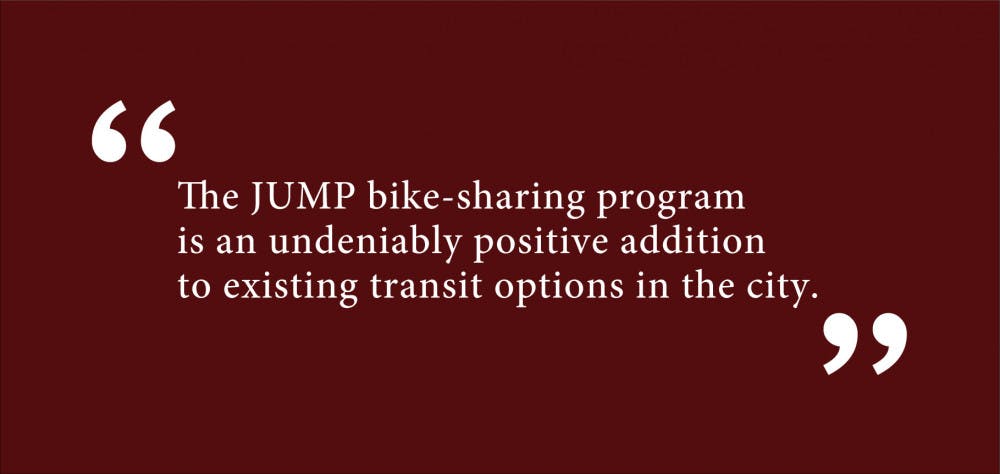In early September, JUMP — the dockless bike-share program owned by Uber — launched in Providence, giving College Hill and other neighborhoods around the city a colorful makeover with its bright red bicycles. The bikes can now be found at 40 docking hubs throughout Providence, and can be easily returned to any public location where the bike can be attached to a fixed installation, such as a bike rack or streetlight. A result of seven years of efforts to bring a bike-share program to Providence, JUMP electric bikes offer numerous benefits to the city and its community members with a new, sustainable mode of transportation. This long-awaited initiative is a much-needed addition to local public transit; we applaud its implementation in Providence, along with the diverse array of stakeholders who made the program possible in the first place.
As cities look for ways to ward off heavy vehicle congestion, bike-share programs have become an increasingly popular option for urban planners since bikes are, in fact, incredibly effective in reducing traffic. One 2014 study found that the 1,325 bikes operating in Minneapolis/St. Paul’s bike-share scheme contributed to a reduction of 55,000 car miles in just one year. This decrease in car travel not only curtails traffic congestion but also allows cities to reduce fuel consumption, carbon emissions and noise pollution, while encouraging commuters to live physically active lifestyles.
Bike-share programs are also an effective mechanism for sustainable growth and development. Studies have linked bike-share programs to clear economic benefits; the improved spatial connectivity and accessibility afforded by bicycles result in increased local business patronage and activity. The biggest benefit provided by bike-share programs, according to some researchers, is the economic efficiency unlocked by reduced travel times, increased access to the city and its inhabitants and greater workforce participation. In short, bike share programs allow a larger proportion of urban populations to engage in their communities and local commercial activity at an affordable price.
Over time, bike-share programs act as a multiplier of the aforementioned effects by creating a cycling culture, normalizing biking as a desirable form of urban transportation. Research has found that people’s willingness to use bicycles as a mode of transport increases when there are a large number of cyclists in a community. Furthermore, if more people begin to bike, traffic safety increases and injuries are reduced. In other words, Programs like JUMP help foster a greater desire among communities as a whole to rely on bicycles as a mode of urban transport, even beyond users of the program.
Providence’s new bike-share program contributes nicely to the city’s broader transportation goals. Since 1990, Providence has identified biking as an important transit option within the city and has worked on a number of infrastructure improvements to promote urban biking since then. Mayor Jorge Elorza’s time in office has brought an increased focus to this initiative; in his 2014 campaign, Elorza promised to bolster biking infrastructure by adding bike lanes and parking, creating programs around bike safety education and bringing bike sharing to Providence. With the introduction of JUMP bikes, Providence has made it clear that safe, accessible and effective transportation is a critical component of urban life by making tremendous strides toward integrating bikes into broader urban development plans.
Critics have fairly pointed out that the program can do more to make sure these benefits are more equitably distributed across the city. For example, JUMP bike docking sites populate the East Side and are more sparsely distributed in areas like Olneyville and Washington Park. Given the economic advantages of urban bike-share systems, it should be a long-term aspiration for the program to disperse advantages more equitably, and be more accessible to low-income, underserved neighborhoods in Providence.
In the past, The Herald has bemoaned, not particularly productively, the state of public transportation in Providence. But the JUMP bike-share program is an undeniably positive addition to existing transit options in the city. Just as importantly, it represents a laudably fruitful partnership between a large number of stakeholders in Providence. The University, for example, convened an internal task force comprised of students, staff and faculty that advised the city on the program’s initiation and identified good locations for bike hubs on campus. The Rhode Island Public Transportation Authority and the Rhode Island School of Design, among other Providence-area organizations, were also involved in the program’s planning. In this way, JUMP bikes are a model for collaboration between public interests and private institutions in the city. Their contributions to life in Providence — from the standpoints of commerce, community engagement and public safety — will certainly be felt for years to come.
Editorials are written by The Herald’s editorial page board: Anuj Krishnamurthy ’19, Rhaime Kim ’20, Grace Layer ’20, Mark Liang ’19 and Krista Stapleford ’21. Please send responses to this opinion to letters@browndailyherald.com and op-eds to opinions@browndailyherald.com.
Correction: A previous version of this editorial stated that JUMP bike docking sites are predominantly situated in the East Side. In fact, 15 of the 46 hub locations are in the East Side. The Herald regrets the error.





